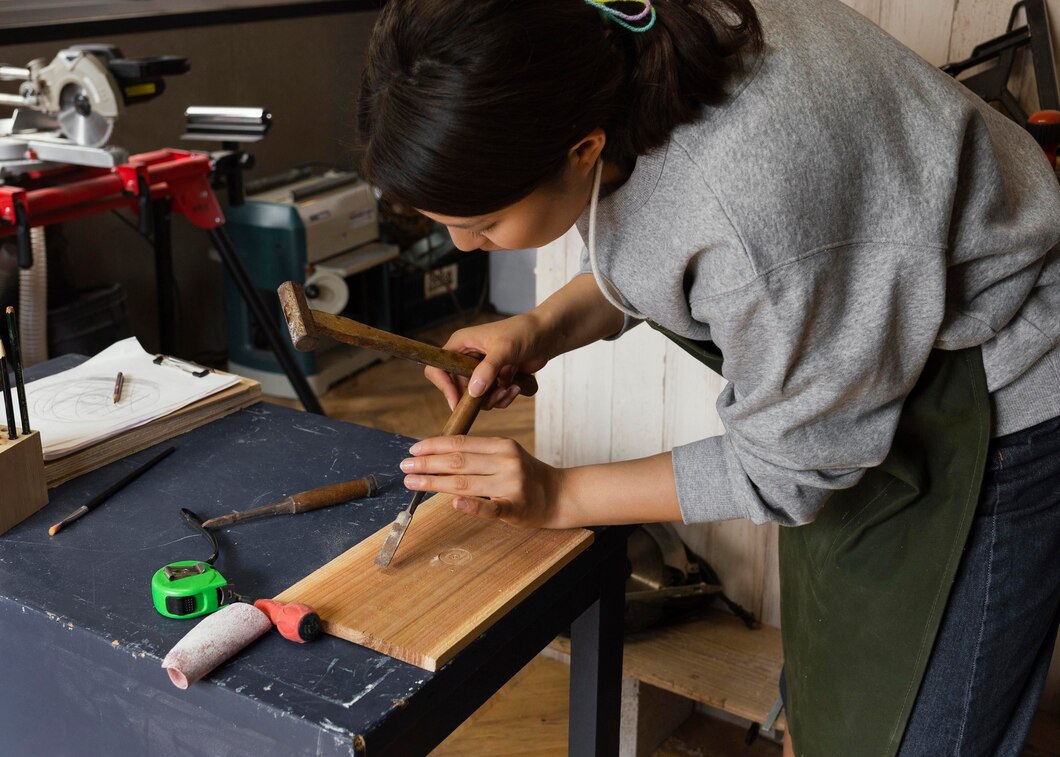The DIY & Crafts Blog

How to Start a Small Woodworking Business from Home
Do you love working with wood? Do you dream of making money from it? Handmade goods and DIY crafts are in demand now. It’s a great time to start a home woodworking business. This guide will help you choose products, set up your workshop, and market your work. Whether you’re an expert or a beginner, you’ll find useful tips here. By the end, you’ll have a clear plan to turn your hobby into a successful business.
Pro Tip: Always test your product durability before selling. Customers value quality, and a well-made piece will earn you repeat business and positive reviews.
Quick Guide:Step By Step Summary
- Start Small: Focus on simple, in-demand projects before scaling up.
- Research the Market: Check Etsy, eBay, and craft fairs for trending products.
- Invest in Quality Tools: Reliable tools improve efficiency and product quality.
- Price Smartly: Factor in material costs, labor, and overhead for fair pricing.
- Build an Online Presence: Use social media and e-commerce platforms to reach customers.
Important Tip:High-quality wood leads to satisfied customers and repeat sales.
Why Start a Home-Based Woodworking Business?

1. Low Startup Costs
You can begin with minimal investment in tools and materials, making woodworking accessible for beginners.
2. Flexible Work Schedule
Work on your projects at your own pace, making it an ideal side hustle or full-time venture.
3. High Demand for Handmade Products
Personalized and handcrafted wood items are always in demand, offering unique value that mass production cannot replicate.
4. Creative Fulfillment
Turn your passion into a business while crafting one-of-a-kind pieces.
5. Scalable Growth
Start with simple products and expand into more complex woodworking projects as your skills and customer base grow.
Step 1: Choose Your Niche and Products
Selecting the right products to sell is crucial for success.
Popular Woodworking Products to Sell
- Home Décor: Wooden signs, picture frames, shelves, and decorative trays.
- Furniture: Coffee tables, bookshelves, nightstands, and benches.
- Kitchenware: Cutting boards, utensil holders, spice racks, and serving trays.
- Toys and Games: Wooden puzzles, board games, and stacking toys.
- Personalized Items: Engraved wooden gifts, custom name plaques, and keychains.
- Seasonal Crafts: Christmas ornaments, Halloween decorations, and wreaths.
How to Choose the Right Products
- Start Small: Pick easy-to-make products requiring minimal tools.
- Analyze Market Trends: Check online marketplaces to see what’s popular.
- Consider Your Skill Level: Choose projects that match your expertise.
- Balance Costs & Profits: Ensure products are cost-effective while maintaining quality.
Step 2: Set Up Your Woodworking Workshop

Creating a functional and safe workspace is essential.
Essential Tools and Equipment
- Basic Hand Tools: Chisels, hammers, hand saws, measuring tape, and clamps.
- Power Tools: Circular saw, drill press, router, jigsaw, and sander.
- Finishing Supplies: Stains, varnishes, wood glue, and sealers.
- Safety Gear: Glasses, ear protection, dust masks, and gloves.
- Workbenches & Storage: Shelving, pegboards, and tool chests for organization.
Organizing Your Space
- Proper Ventilation: Reduces dust and fumes for a healthier environment.
- Adequate Lighting: Essential for precision work.
- Safety First: Keep the area clutter-free and follow best practices.
Step 3: Source Materials and Manage Costs
Finding affordable, high-quality materials boosts profitability.
Where to Buy Wood & Supplies
- Local Lumber Yards: Buy in bulk for savings.
- Reclaimed Wood: Great for eco-friendly projects.
- Online Suppliers: Find specialty wood and tools.
- Hardware Stores: Purchase screws, hinges, and finishes in bulk.
Cost-Saving Tips
- Compare multiple suppliers for the best deals.
- Minimize waste by optimizing wood usage.
- Explore budget-friendly alternatives like plywood and MDF.
- Check local classifieds for discounted or free materials.
Step 4: Pricing Your Woodworking Projects
Pricing correctly ensures profitability. Use this formula:
(Material Cost + Labor + Overhead) x Profit Margin = Selling Price
Additional Pricing Strategies
- Competitive Analysis: Research similar products.
- Bundling: Offer package deals for larger sales.
- Limited Editions & Custom Orders: Charge premium prices for exclusivity.
Step 5: Selling Your Woodworking Products

Explore different sales channels:
Online Marketplaces
- Etsy: Best for handmade and personalized wood products.
- eBay: Ideal for unique, high-quality items.
- Amazon Handmade: Large customer base for artisans.
- Your Website: Reduce fees and build a brand.
Local Sales Opportunities
- Craft Fairs & Markets: Meet customers face-to-face.
- Social Media Sales: Sell through Facebook Marketplace and Instagram Shops.
- Partner with Local Businesses: Work with boutiques and gift shops.
Step 6: Marketing and Growing Your Business
Promoting your business effectively attracts customers and boosts sales.
Build an Online Presence
- Create a Business Website: Showcase your products and contact details.
- Social Media Marketing: Share photos, customer reviews, and behind-the-scenes content.
- SEO Optimization: Use relevant keywords in product descriptions to attract buyers.
Scaling Your Business
- Expand your product line based on customer feedback.
- Consider hiring help as demand grows.
- Upgrade tools for improved efficiency.
Frequently Asked Questions (FAQs)
1. How much money do I need to start a woodworking business?
You can start with as little as $500–$1,000 if you already own some basic tools. The cost depends on the tools, materials, and workspace setup.
2. Do I need woodworking experience to start a business?
Not necessarily. You can start with simple projects and gradually improve your skills through practice, tutorials, and courses.
3. Where can I sell my woodworking products?
You can sell on Etsy, eBay, Amazon Handmade, craft fairs, social media platforms, and even your own website.
4. What types of wood should I use for my projects?
Hardwoods like oak, maple, and walnut are durable and premium, while softwoods like pine and cedar are more affordable and easier to work with.
5. How do I price my woodworking products?
Use this formula: (Material Cost + Labor + Overhead) x Profit Margin = Selling Price. Research competitors to stay competitive.
6. Do I need any licenses or permits to sell woodworking products?
It depends on your location. Check local business regulations for home-based businesses, tax requirements, and safety regulations.
7. How can I market my woodworking business effectively?
Utilize social media, build a website, take high-quality product photos, offer promotions, and network at craft fairs.
8. How do I ensure product quality?
Use high-quality wood, test durability, apply proper finishes, and inspect products before selling.
Conclusion: Turn Your Passion into Profit
Starting a small woodworking business at home can be both rewarding and profitable. Choose the right products, set up an efficient workshop, and use smart marketing. You can turn your woodworking skills into a sustainable business. Now is the perfect time to act. Start small, refine your craft, and grow your business step by step. Have questions? Drop a comment below, and let’s build your success together!









